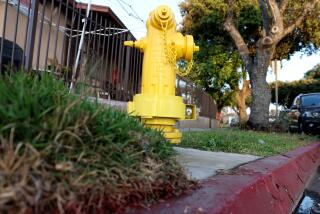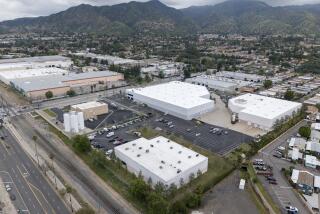Nothing is sacred to metal thieves
HATFIELD BROAD OAK, ENGLAND — Naomi Wormell is a vicar, not a vigilante. But these days, she finds it hard to choose Christian charity over some swift -- and terrible -- retribution.
The centuries-old church she leads in this quiet English village has fallen victim to a plague sweeping across Britain. Like hungry locusts, metal thieves have repeatedly attacked St. Mary’s Church, swooping down on its roof in the dead of night and stripping away large sections of its Victorian-era lead cladding.
Six times over a four-month period, the heartsick residents of Hatfield Broad Oak awoke to discover yet another piece of their history stolen, most likely to be melted down and sold for scrap. The losses are part of the estimated $1.2 billion a year sucked out of the British economy by crooks with a voracious appetite for all things shiny.
Wormell admonishes her congregation to resist the urge to give divine wrath a helping hand if the church’s newly installed alarm goes off, even though she confesses to the same temptation.
“I’ve asked parishioners not to come out with pitchforks, because these are violent men,” she said of the metal thieves. “I don’t want to bury any parishioners.”
The soaring thefts track a surge in worldwide metal prices. Demand for metals such as copper and lead has boomed as rapidly developing countries including China and India race to build skyscrapers, factories, homes and gadgets for a rising middle class.
Thieves in Britain are ripping up railway and telephone cables, prying off manhole covers and carting away aluminum access ramps for the disabled. Children shiver in schools where heating pipes have been stolen. In a development Prime Minister David Cameron denounced as “absolutely sickening,” memorials to fallen soldiers are being pilfered at the rate of one to two a week.
Last year, grave robbers dug up six tombs in a Welsh cemetery, apparently in search of lead coffin linings. In the English coastal town of Blackpool, despairing officials were forced to pull public artworks from display after thieves lifted three of four lead-based figures from a park and part of a statue from the seaside promenade.
The nationwide epidemic prompted Scotland Yard to announce in December that it was forming a unit devoted to tackling metal theft. But apparently someone forgot to notify the poachers, who, that same day, helped themselves to a large outdoor bronze sculpture by noted artist Barbara Hepworth, valued at $800,000, in South London.
Thieves have targeted Britain’s extensive railway network so often that the British Transport Police says thwarting them is second in importance only to preventing a terrorist attack. Officers arrested more than 1,000 suspects last year who allegedly tried to take everything from copper cables -- the preferred booty -- to cabinet doors and rails.
“Often it’s just two to three people wandering down the railway and dragging off what they can get,” said Glyn Hellam, a spokesman for the force. “The vast majority of the railway runs through rural locations where you can’t have people stationed at all times.... It’s impossible to patrol.”
The British are not alone in their growing losses to enterprising metal thieves. Other European countries are struggling with the same problem, including Germany, whose rail system has also taken a big hit. But the extent of the thievery and the wide variety of targets in Britain have been especially notable.
Even though the sums that metal thieves earn from scrap dealers are often surprisingly small, the money is proving irresistible at a time of high unemployment, economic belt-tightening and painful government cuts across Britain. Authorities suspect that organized gangs may be behind some of the heists.
To discourage them, experts are urging stricter regulation of the scrap metal business, an industry governed by 48-year-old rules that critics say are hopelessly out of date and inadequate for contemporary conditions. Why, for example, are people still allowed to trade in large metal items for cash upfront, no questions asked? Why not require some form of identification?
“The best way of tackling this is to work with scrap metal dealers so the thieves who are taking the metals have nowhere to sell,” Hellam said. “What we really need to do is stop the market for stolen metal.”
The effect of the plunder can go far beyond the economic. In December, thieves took 100 yards of cabling from a generator in a hospital in Llandough, Wales, forcing doctors to cancel 81 operations, including several for cancer patients.
In another brazen attack, the attempted theft of a communications cable in Hertfordshire knocked out phone and Internet access across a broad swath of the southern part of the county, including at the control center of the local constabulary. Police had to switch over to backup systems to make sure they didn’t miss emergency calls.
The thieves themselves can be at risk of dire consequences: Ten people have been killed in the last year filching metal, many of them electrocuted while trying to yank out cables alongside rail lines or at power stations. Public sympathy has not been high.
With police resources stretched thin, some potential victims have had to come up with their own solutions for protecting themselves. Just ask the congregation of St. Andrew’s Church in the community of Hornchurch on the outskirts of London.
Like St. Mary’s in Hatfield Broad Oak, St. Andrew’s belongs to the Diocese of Chelmsford in southeastern England, which reported nearly 100 instances of metal theft in 2011, making it the hardest-hit diocese in all of Britain during a record year for such crimes.
The glittering prize at St. Andrew’s, a drafty stone building dating back to medieval times, is its copper-covered roof. More than a century old, it managed to survive a bomb that landed perilously close during the Blitz in World War II. But it was defenseless against the thieves who started ripping off pieces in April.
During one especially bad week in the summer, thieves struck three times. So parishioners decided to take turns spending the night in the church to catch raiders red-handed. They bedded down in the chancel and used flashlights after dark to keep as inconspicuous as possible.
“You don’t fully appreciate how cold this church can get until you sleep here through the night,” Andy Losq, the organist, said.
Only once did the sentry squad catch a pair of would-be robbers in the act. After the men clambered onto the church roof, the self-appointed guards hidden inside alerted police, who arrested one of them. The other fled.
At least a quarter of the copper roof has been stolen, which led to another disaster in October when heavy rains soaked through the exposed wooden ceiling and flooded the organ below. The instrument is out of commission as it awaits repairs costing about $24,000.
“I know this organ inside out. This is the instrument I learned on as a child, so it’s an instrument that’s close to my heart,” Losq said. “It was like being violated, really.”
An alarm system installed at St. Andrew’s a few months ago seems to be doing the trick in preventing more thefts. Attacks on St. Mary’s in Hatfield Broad Oak have also tailed off since the church added its security system. But a third of its lead roof is already gone and will cost tens of thousands of dollars to replace.
“As a child, you always imagined that people didn’t steal things from churches, because as they walked out they’d be struck down by a lightning bolt from God,” said Mike Nash, the longtime treasurer of St. Mary’s. “It’s a desecration of something that’s sacred to a lot of people.”
Wormell, St. Mary’s vicar, wants to avoid drastic security measures, such as setting up surveillance cameras around the church’s perimeter.
“There’s that balance between keeping it an open place that anyone can come into but also keeping it secure enough so that no one walks off with it,” she said. “This is a church, not a fortress.”
--
More to Read
Sign up for Essential California
The most important California stories and recommendations in your inbox every morning.
You may occasionally receive promotional content from the Los Angeles Times.











